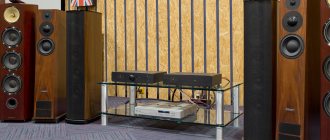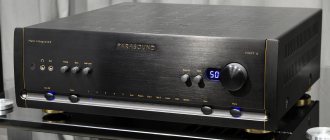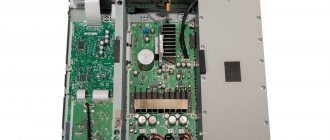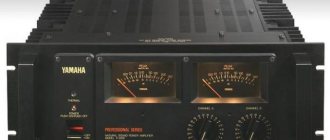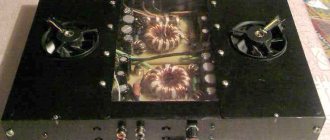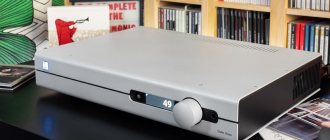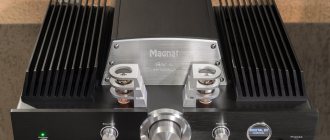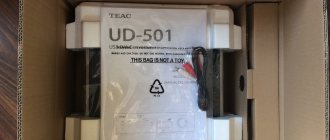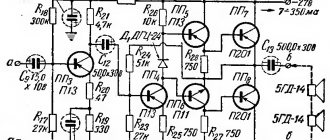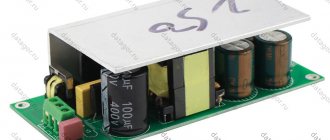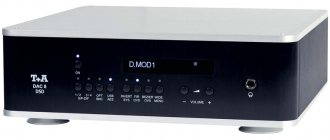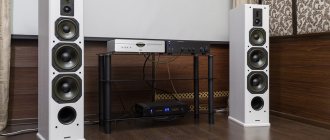I have always treated automatic sound calibration systems with a great deal of wariness and doubt, but on the contrary, I highly trust direct digital signal amplification and consider this technology to be the most audiophile and correct. And suddenly Peter Lyngdorf combined these two technologies in the new Lyngdorf TDAI-2170 amplifier. Well, what to do here? I had to urgently go to the Nazarov gallery to find out how it works, and whether auto-calibration deserves the right to exist in the High End world.
As a developer, Peter Lyngdorf commands only respect from me and nothing more. After all, it was he who, while working at NAD, created DirectDigital amplifiers, and also managed to do a lot at McIntosh and Steinway Lyngdorf. In a word, his contribution to the development of the global Hi-Fi industry can hardly be overestimated. The Lyngdorf company is a relatively new project of St. Petersburg, engaged in the production of a small number of High End components based on the latest developments in the field of digital audio. Well, the integrated amplifier Lyngdorf TDAI-2170 is probably the most advanced device, not only in the company’s line, but also in the industry as a whole.
Acquaintance
Since the power amplifiers inside the Lyngdorf TDAI-2170 are designed to work with a digital signal, the scenario for its use seems to me, in comparison with traditions, to be a kind of photographic negative. It would seem that any integrated amplifier, even one operating in class D, needs an analog connection. This is understandable, because an analog signal must be supplied to the power amplifier board inside the device, and even if the amplifier has a set of digital inputs, the DAC still works after them. So for the Lyngdorf TDAI-2170, analog inputs are exactly the same option as for other amplifiers - digital. In order for this amplifier to reproduce an analog signal, it must first be converted to digital. The Lyngdorf TDAI-2170 has analog inputs and an ADC installed behind them, but the main set of inputs are coaxials and optics, which are present in abundance on the switching platform.
The Lyngdorf TDAI-1270 amplifier is made in the best traditions of Scandinavian design: simple and functional
It is also worth noting the presence of digital and analog outputs. With their help, you can integrate an amplifier into a complex installation and use it with branded power amplifiers, which, by the way, are connected digitally.
Technologies
Looking inside the case, an old-school audiophile is unlikely to recognize the Lyngdorf TDAI-2170 as an amplifier. It does not have powerful transistors or radiators, and transformers are only suitable for a phone charger. What kind of 170 W per channel?! However, not everything is so simple in modern technology. The power supply is switching, which has a significantly higher efficiency than a conventional transformer or toroid. In my opinion, switching power supplies often outperform models with traditional transformers and large blocks of the best capacitors in sound dynamics.
It is worth paying attention to the large number of power filters. They are present both at the input and in the power supply itself, before and after the voltage converter. This means that network interference will not get into the signal part, and a network air conditioner is unlikely to significantly improve the sound quality. And from the point of view of the quality of operation of digital circuits, noise protection is an extremely important point. The slightest noise in the power supply inevitably increases jitter significantly.
The volume adjustment step is very small, but the handle can be turned like the steering wheel of a ship - you push once and by inertia it makes several full turns
But what is especially interesting is that the power supply in the Lyngdorf TDAI-2170 does not just perform the function of supplying energy to the power amplifier: it is used to control the volume. While in a conventional amplifier turning the volume control changes the level of the incoming signal, here it changes the level of voltage supplied to the power amplifier. Thanks to this, it is possible to avoid unnecessary interference with the signal, because it exists in the device in digital form and recalculating it again is not comme il faut at all.
I have already said that the amplifier is completely digital, and in addition we can only briefly formulate its operating principle. The digital signal received at the input actually undergoes only one transformation from a pulse-code form (PCM) to a pulse-width form (PWM or PWM in Russian). Then everything is simple: the energy of the power supply is used to increase the amplitude of the pulses, and simple filters at the output finally give them an analogue appearance. In the Lyngdorf TDAI-2170 amplifier, the operating PWM frequency reaches 400 MHz, which exceeds that of many competitors and allows you to obtain the purest analog signal at the output.
In the fight for truth
But Peter Lyngdorff did not limit himself to just direct reproduction of the “digital”. He decided to join the Great Battle - the same “Loudness War”. Of course, on the side of good and audiophilia. As you know, modern recording studios have long dabbled in compressing the dynamic range, trying to adapt the sound of music to the completely non-audiophile characteristics of smartphones and popular “white” headphones.
To achieve the desired effect, namely high average volume, the recording is run through a compressor, which raises the average signal level closer to the maximum volume, while the original dynamic range is driven within a few decibels. In this case, signal peaks suffer especially strongly: those that go above the maximum volume are simply cut off. The lack of sufficient dynamic range removes the feeling of emotional intensity and drama from the music; everything sounds smooth, as if on one note. And, unfortunately, many records have already been made in this vein.
All groups of connectors screwed into the cover plate are optional modules
Lyngdorf ICC technology provides dynamic range correction. The presence of compression in a signal is recognized by its shape. If compression of the dynamic range has taken place, the signal spectrum will have extended sections with a consistently high level - this is what a peak cut off during the compression process looks like. ICC technology, according to the company, restores the original shape of the peaks, thereby expanding the dynamic range and returning the music to its pre-compression character. The maximum added signal amplitude is 12 dB. I note that modern recordings are often squeezed into a much narrower framework.
We scold
So has Lyngdorf surpassed my “music center”? In terms of effectiveness and technicality, it certainly surpassed it. But... Here's what my wife said:
If a young man invites a girl to his home, feeds her with treats, drinks her with fine wine and they listen to Lyngdorf, the girl will be impressed, will be very pleased and will then tell all her friends what a good time she had. But he won't. But if they listen to Arkhipov and Rega, they will give in, even if the wine and treats are not very good.
To put this in more audiophile terms, Lyngdorff is good with sounds and their cohesion, he knows how to put sounds into musical phrases, but it doesn’t go further than that. There is no complete and exciting story that makes you empathize, with its own atmosphere, plot, climax and denouement. The music performed by Lyngdorff is somewhat reminiscent of a diligent student at a music school - he learned the notes, improved his technique, even listened to concerts and recordings of recognized performers and tries to imitate them. But he lacks charisma, life experience, his own “I”, which he can put into the music he performs. Instead, he tries to play everything beautifully and effectively, and this does not benefit all music. A couple of examples:
A) Lyngdorf fails to play this album:
Instead of conveying (and maybe even emphasizing) the uncertainty and instability of the performance, he tries to correct the mistakes of the performers and generally make normal music out of the nonsense that they play there. The meaning is completely lost.
B) In this piece, Lyngdorf does not understand what is primary and what is secondary, where the main thing needs to be highlighted and what needs to be put into the shadows.
The result is simply a set of spectacular fragments: Gagarin, instead of thoughtfully contemplating the Earth from space, fussily posts stories on Instagram.
In general, after listening to the “music center” you are left with the right feeling of fullness, like after a good concert. There is nothing left after Lingdorf - well, yes, the guys played great, well done, I liked it, goodbye, I ran.
And yet, despite the lack of digitizer, after listening to Lyngdorf for a long time you get pretty tired - not with your ears, but rather with your head, perhaps there is too much “wow” in the sound.
Triple upgrade
Manufacturers who have provided hardware upgrades for their Hi-Fi components can be counted on one hand. Off the top of my head I can only think of NAD and Primare. Now Lyngdorf has been added to my list. The very idea of a hardware upgrade is very good for those who do not like to pay extra for functions that they do not plan to use.
Automakers set an excellent example in this regard, and the price of the simplest and most complete configuration can differ radically. In the case of the Lyngdorf TDAI-2170, which has three optional boards, the price tag of the basic and top-end configurations differs by about a quarter: 275,000 and 380,000 rubles (hereinafter - prices for July 2016).
Simple and reliable terminals support all common cable connection methods
What can the owner of the basic version additionally please himself with? For starters, an HDMI switching board. With this upgrade, the Lyngdorf TDAI-2170 can easily serve as an AV receiver (if the latter is not present in your system and is not planned). The board has four inputs and one output. It supports the ARC audio return channel, which allows you to play audio from the TV, as well as the CEC control protocol, which synchronizes power-on and allows you to adjust the volume from the TV remote control. There are also technologies useful when listening to music: working with HDMI, the Lyngdorf TDAI-2170 can play DSD64 and DSD128 streams.
The second upgrade is directly related to music. This is a high-end USB module. I would like to write a DAC, but it just doesn’t come to that. The device allows you to receive PCM up to 32 bit/384 kHz, DXD, DSD64 and DSD128 via USB protocol. The connection to the computer is asynchronous and requires installation of the original driver.
The USB port on the rear panel is used for firmware updates, but it can be used to power external devices, such as a wireless HDMI Chromecast module
The third upgrade is dedicated to owners of vinyl players, as well as those who fundamentally want to use the analog output of their High-End player instead of a direct digital connection. Why High End class? Because if we are talking about an inexpensive or mid-budget device, then the basic analog inputs of the Lyngdorf TDAI-2170 are quite enough. The high-end module offers a balanced input, which is not included as standard. In addition, it uses a high-quality ADC AK5394A from Asahi Kasei, commonly used in professional studio equipment and has a dynamic range of 123 dB. The signal level at each analog input can be adjusted within a range of 24 dB, which allows you to correct the lack or excess of volume of a particular source.
Hi-Fi class auto calibration
Auto-calibration systems appeared and developed as an integral part of cinema equipment. This did not catch on in hi-fi because it was considered unacceptable signal interference. If we look at the issue from a theoretical point of view, then calibration may well be an effective measure. When the system has received reliable data on the real frequency response and phase response, the frequency response and phase can be adjusted without any problems. Why not? In the cinema world, a successful example of this has been provided by Trinnov with their technology for analyzing room acoustics in three dimensions. The technology is truly breakthrough and cosmic, but the price, as far as I remember, matches.
Before the listener sits down in the chair, there will be an auto-calibration microphone
RoomPerfect is a proprietary technology developed by Lyngdorf and uses one microphone for measurements, which is already included in the standard package along with the stand. Test signals are already recorded in the amplifier's memory, and this is not broadband noise, not a sine wave or sweep tone, but some equivalent of a musical signal. The sound is very similar to the soundtrack to a horror film: shrill and ringing high-frequency sounds alternate with a uterine low-frequency hum and mid-frequency muttering.
Measurement starts from the point where the listening area will be located. You can choose either one - there will be the best focusing, or two to immediately designate the zone where the processor will “direct” the sound. After this, the microphone must be installed at arbitrary points in the room at different heights, and the amplifier, based on the results of measurements, will show in percentage how completely it was able to form an idea of the acoustics of the room.
The duration of the setup procedure depends on the specifics of the room and the degree of imagination with which you approach the choice of arbitrary microphone installation locations. If you are not sure of the results, you can save several of these settings in memory and then compare them with each other.
Bottom line
The first and main conclusion is that high-quality automatic sound correction in a high-end system is not a utopian thing, but quite viable and actually existing. There is an effect, and during testing I was not able to notice any negative effects. Those in the know say that the RoomPerfect system helps the amplifier cope with almost any acoustic environment. What I heard is quite consistent with this.
To be fair, I note that the testing was carried out in fairly good conditions, but on the other hand, who would install a High-End system haphazardly in the hope that the electronics will fix everything?
5-7 years ago I would have had a hard time recognizing the amplifier in this picture. But technology does not stand still, a High-End amplifier can now look like this
In terms of sound quality, the Lyngdorf TDAI-2170, in my opinion, is very good even without calibration, and even with it, it’s completely close to ideal. The only reason why this amplifier will not conquer the world in the near future is the inertia of thinking and perception. Still, the concept of High End, in addition to sound perfection, also includes certain traditions, habits, and ideology. In this regard, Peter Lyngdorf, with his albeit effective, but purely engineering approach, goes against the usual image of a High End amplifier. So it turns out that the Lyngdorf TDAI-2170 is, on the one hand, a much greater High End than monstrous amplifiers based on tubes with an uneven frequency response and off-scale distortion, and on the other hand, it is something fundamentally new, forcing us to look at the design issue differently stereo systems and the high-end industry as a whole. Which is more true? Time will show.
Before and after
According to reviews from those who have already tested the Lyngdorf TDAI-2170, the quality class of this amplifier is so high that it is worth choosing acoustics that are not comparable, but of greater cost. Therefore, we chose two floor-standing models for the test: Audio Physic Avanti costing 427,500 rubles and Piega Classic 60.2 costing 892,500 rubles. And the Lyngdorf TDAI-2170 itself, let me remind you, even when fully equipped does not reach the 400,000 ruble mark.
The calibration procedure took no more than 20 minutes in both cases. After this, three setting options became available in the amplifier menu: Focus - when the sound is concentrated at the listening point, Global - for an even “focus” throughout the room, and Bypass, when the RoomPerfect function is disabled.
The calibration microphone must be installed in different zones and at different heights, including outside the stereo base
It is worth noting that in both cases the sound was quite good even before calibration, because the room was acoustically well prepared, and the speakers themselves were optimally placed. But the amplifier was given a difficult task, because both pairs of speakers cannot be called a light load. Both are designed for high power input. Audio Physic Avanti also have a relatively low sensitivity, only 88 dB. However, the Lyngdorf TDAI-2170 coped with the task surprisingly confidently.
Two main effects from auto-calibration were noticed. Firstly, the scene became much more focused and three-dimensional. And when switching from Focus mode to Bypass mode, the sound picture seemed to blur, clearly localized instruments scattered in all directions or even fell into a heap.
The amplifier looks beautiful and concise, but when the display is turned off you won’t immediately understand what kind of device it is
The second noticeable effect was a strong change in the character of the bass sound. The drone and drawn-out notes disappeared, there was extreme clarity and composure, and deeper notes began to be heard. They say that the Lyngdorf TDAI-2170 performs a similar trick even with bookshelf speakers, significantly expanding the reproduced frequency range downward. In addition, calibrated sound is perceived as more intelligible and natural. Long-term listening showed that it is more comfortable to listen to music in the tuned form, and after several hours there is no fatigue.
Even the powerful Lyngdorf TDAI-2170 acoustics are no good. He confidently handled the large Piega Classic 60.2
It is worth noting that the Lyngdorf TDAI-2170 does not completely change the sound character of the acoustics and does not make all speakers similar to each other. Another interesting observation: the Piega Classic 60.2 initially sounded more balanced than the Audio Physic Avanti, and after calibration the changes in its sound were less noticeable. This allows us to draw two conclusions. Firstly, auto-calibration cannot improve the sound of ideal acoustics in an ideal room, because there are no problems that it is designed to solve. Secondly, the Lyngdorf TDAI-2170 is quite capable of bringing the sound of non-ideal acoustics in non-ideal conditions closer to ideal.
We praise
At first, the black box is puzzling with its frivolous size and weight. Everyone knows that without a pound of motor products and a kilogram of radiators, there will be no real sound. On the other hand, a serious approach to business is reassuring. The Quick Setup Guide, printed on a sheet of thick coated cardboard, makes you want to hang it in a frame on the wall, it looks so beautiful and solid. In some ways it is reminiscent of 12″ vinyl sleeves, which are simply pleasant to hold in your hands - a rare quality in our times. Putting in the kit a measuring microphone, a stand for it (!) and 8 meters of XLR cable and not putting designer wooden boxes and some kind of certificate of authenticity with the signature of the Maestro himself, this also speaks of the seriousness of intentions - to be, and not to appear.
After a little network setup and warming up, the device immediately produces decent sound. No, the sky did not fall to the ground, and the wife did not come running from the kitchen, but the basic level is already quite listenable: a bodily, timbrally full sound, without obvious digitization, plastic, with good dynamics and resolution. The level of previous combines was surpassed from the very first notes, surprise. But can Lyngdorf surpass the level of my audiophile “music center”?
At first, he is noticeably inferior in some things. The timbres are tasty, but not too natural - the piano plays with a plastic tint, and you can also hear synthetics in the voices. The rhythm is worked out clearly, but too simplified and restrained; the device does not paint a rhythmic picture with broad strokes, but carefully paints it over the cells - squares, practicalities. The parts of the instruments are slightly shifted relative to each other, this does not hurt the ear, but you get the feeling that you are looking at cats generated by a neural network - they are quite similar to real ones, but... then the eyes look in different directions, then the ear will fall off, then the mouth will warp. Well, let's start the upgrades.
The first thing I do is unpack the microphone and run the RoomPerfect calibration. Fifteen minutes of humming and rattling into the speakers (if only the cat didn’t start meowing, singing along with the buzzers, and didn’t start rubbing against the microphone stand, but everything works out), several rearrangements of the microphone, and the Room Knowledge index reaches 97%.
Wow! The sound rose to another level. Synthetics and out of sync are gone, the timbres are filled with juices, sound production has become free and easy. In general, freedom of sound production is a rather rare and fragile quality; I never expected to find it in a digital combine. The only drawback of the calibration is that my baby speakers have a weak bass response, naturally RoomPerfect noticed this and tried to add more lower bass, which the babies still can’t handle and instead just hum and hoot. After turning on the Subsonic filter in the settings, the sound improved, but a slight hoot remained. Perhaps the problem would have been solved by connecting a subwoofer, but I didn’t want to tinker with its settings. Another interesting point is that Focus position significantly affects the final sound; you can record several different positions to choose the best one. My wife likes to listen to the system while sitting with her back to her, I recorded this position too, and, surprisingly, it turned out to be the most pleasant to the ear.
But, even after calibration, the presentation as a whole is still dull and not very interesting - somewhat reminiscent of the RME ADI-2. On the one hand, everything seems to be fine and there is nothing to complain about, on the other hand, it doesn’t really involve, it plays without a spark.
What if I use the spdif input and connect my upgraded 502 hat? Of course, control through the built-in Roon client is much more convenient than adjusting the volume and settings in one application and controlling music in another, but you won’t go to any lengths for sound.
So, I connect the 502 hat, and the pants turn into... Wow! The device opened to its full height. The rhythmic tightness and general “grayness” of presentation disappeared, artistry and mobility appeared. This is already interesting to listen to. The talents of the 502 DAC combined with Lyngdorff's speed, precision and tonal richness created an impressive cocktail. Absolute blackness of pauses, precisely defined contours of sounds, it seems even slightly outlined by thick lines, transparency and intelligibility, impeccable work with rhythm and after-sounds, overall richness of sound - someone compared the sound of Lyngdorf with a good OLED screen, in my opinion this is a very accurate comparison.
I experimented with power cables, the device is quite responsive to them. The best presentation turned out to be with Tchernov Classic - not very catchy, but the most natural “analogue” (although the stage was somewhat smaller). With vintage copper cables the sound was too colored. Tchernov Classic is the most neutral of the powerhouses I've tried - this suggests that Lyngdorf is well balanced and does not need additional sound enhancers and harmonizers.
But the results of the experiment with connecting Lyngdorf through an isolation transformer (Toyozumi 600VA with an interwinding shield) did not work for me. Yes, everything cleared up somewhat and became more plastic, but the sound turned into some kind of taffy, the tempo slowed down, and the music became painfully sad. I connected a raspberry hat through the same RT - the effects became less pronounced, but the musical tedium remained. In general, I didn't like it.
Time to listen
The sound in Focus mode has the best focus of the scene and the best tonal balance at the point for which the calibration was made. If you move half a meter, the picture is no longer so good. Global mode allows you to maintain an even tonal balance for most of the room, but the scene focus and localization accuracy are lost. This mode will be good for parties or watching movies with a large group. After a direct comparison of the Focus and Bypass modes, the choice in favor of the first is quite obvious, and I did not notice any objective reasons to refuse calibration.
The sound after calibration encourages you to relax and enjoy the music
As for the contribution of the amplifier to the sound of the system, it is minimal. With the Lyngdorf TDAI-2170, the entire range is reproduced with maximum transparency, detail and clarity. The amplifier provides excellent bass control, very natural midrange delivery, and exceptionally free, airy highs. The dynamics throughout the entire range are excellent. The character of the presentation is neutral, but without some of the harshness and dryness of studio equipment or the academic restraint characteristic of some High-End amplifiers. In my opinion, this approach is as close as possible to the canonical High End - introduce minimal distortion and transmit the music as it is.
Amplifier/media player Lyngdorf TDAI-3400
Danish engineer Peter Lyngdorf realized back in the 90s that the future of audio lay in digital technology. His TACT Millennium was the first High End amplifier to have no analog stages at all, and it was a real breakthrough. In the recently released TDAI-3400 model, the “absolute figure” concept is retained, but implemented at a higher quality and functional level.
To be fair, I must note that TACT Millennium was greeted coolly by the market - the only digital sources at that time were CD players, and the price of 10 thousand dollars for a class D amplifier in the late 90s seemed prohibitive. But it was a device that was far ahead of its time. The idea of a completely digital path never occurred to anyone; In all switching amplifiers, the input PCM was converted to analog, and only then fed to the pulse width modulator. Now that more than 90% of music content is consumed digitally, Peter Lyngdorff's technology, registered more than 20 years ago under the Equibit trademark, could not have come at a better time. While many manufacturers are forced to develop something similar from scratch, Lyngdorf Audio uses and develops decades of experience.
I am very impressed by the Scandinavian style of Lyngdorf Audio - its emphasized rigor testifies to the highest professionalism and non-trivial thinking of the designers.
TDAI-3400 is a completely new development of the company, which became a logical continuation of the previous model TDAI-2170. They are very similar in appearance; the modern device only has one more “window” on the front panel. But this is not an auxiliary display, as I first thought, but really a window to the outside world: the antennas of the built-in Bluetooth and Wi-Fi modules are installed behind the plastic cover. The Danes did not move the “horns” outside so as not to disturb the purity of the lines, and inside a completely closed case the antennas would be of no use. I am very impressed by the Scandinavian style of Lyngdorf Audio - its emphasized rigor testifies to the highest professionalism and non-trivial thinking of the designers.
It is noteworthy that the new device, with the same dimensions as its predecessor (the height of the case is increased by only 5 mm), has a much more advanced filling. The output power of 4-ohm amplifiers has been increased from 2 x 170 to 2 x 400 W, and the load current has been increased to 40 A, while nonlinear distortion is reduced by several hundredths. Moreover, without forced cooling - there are no fans in the device. And all thanks to the fact that high-frequency MOSFETs of a new generation with low channel resistance are used as output switches.
The TDAI-3400 adds a built-in media player with support for Roon Ready, Spotify Connect, DLNA and AirPlay, which can also play audio files via USB and receive Internet radio via vTuner.
The number of settings and adjustments is amazing: their description takes up more than 20 pages in the user manual, and there are 18 sections in the main menu.
The number of settings and adjustments is amazing: their description takes up more than 20 pages in the user manual, and the main menu has 18 sections with several lines in each. The service is truly fantastic - the device can be optimized for several configurations (stereo, home theater), any acoustics and any room. The latter task is solved using the proprietary RoomPerfect auto-calibration system, which analyzes the acoustics of the room through an external microphone, after which it not only corrects the frequency and phase characteristics of the amplifier, but also minimizes the effect of standing waves. The algorithm provides two modes of operation. When set to GLOBAL, the sound is optimized across the entire area of the room (this requires taking several measurements in it), and by selecting FOCUS, the most balanced sound can be obtained at the selected listening point. This mode was used several times when demonstrating the TDAI-2170 at exhibitions, and always gave excellent results.
Among the settings, I will also note 32 frequency response presets in the middle range (Voicing), low-pass and high-pass filters, tone and balance controls, the formation of delays for matching with the subwoofer, limiting the maximum volume, setting sensitivity and other parameters for all, incl. and digital inputs, as well as separate settings for HDMI. For your own speaker systems (as we know, Lyngdorf Audio produces them too), there are ready-made combinations of parameters in the DSP memory - you just need to select the desired model from the menu.
And, of course, the amplifier uses proprietary technologies to eliminate the effects inherent in digital playback. This is the ICC (Intersample Clipping Correction) algorithm, which eliminates clipping and restores the original dynamic range of the signal, as well as a circuit design called Blackground, which ensures absolute “digital” silence in pauses.
The musical balance is maintained very close to ideal; on complex compositions with a large number of instruments, everything is drawn in detail and legibly.
The standard switching of the device (see table at the end of the text) can be expanded using optional modules. One of them contains three HDMI 2.0a inputs with support for ARC, CEC and HDCP 2.2 and one output, and the second contains a set of RCA and XLR line inputs with high-quality buffering. Our device was fully equipped, as can be judged from the photo of its rear panel.
The firmware is updated over the network, and all software, filter parameters and other corrections are loaded from an SD card, which can be easily removed and rewritten if necessary.
Control - from the remote control (works via IR and Bluetooth LFE) or the front panel, as well as through the web interface, IP Control/RS-232 protocols and the Lyngdorf Remote application for mobile devices.
This is what we used to set the UPnP input, disable all filters and activate RoomPerfect Focus. Audio files were taken from the NAS over the local network.
If I had not participated in the switching process myself, I would hardly have believed that audio files were being played, and not of the highest resolution. Despite the fact that the Yamaha NS-5000 acoustics used in our system have colossal resolution in the upper and midranges, neither the dryness characteristic of network audio nor the vacuum in the region of border overtones was noticeable. The musical balance is maintained very close to ideal; on complex compositions with a large number of instruments, everything is drawn in detail and legibly. It seems that to combat jitter, the TDAI-3400 has either an advanced reclocking system or a large-capacity FIFO buffer. The bass is combative, biting, without buzzing overtones or monotony. I liked how the amplifier controls the acoustics - it clearly conveys the attack of the blow, the sharp plucking of the string, and its slightest vibrations, but you don’t feel the looseness of the diffusers. The only thing that was perhaps a little lacking here was real life; the soundtracks sounded somehow detached, without sparkle.
The back wall moved back a couple of meters, and the performers sat in the freed-up space in all three dimensions, just like on a real stage.
Life appeared after we connected the Lyngdorf CD-2 player to the amplifier via a coaxial cable. The sound became more energetic, the bass notes became clearer. The back wall moved back a couple of meters, and the performers sat in the freed-up space in all three dimensions, just like on a real stage. And one more thing: such a harmonious combination of absolute dynamics and filigree depiction of the smallest details is completely uncharacteristic of switching amplifiers. I remember that I criticized the TDAI-2170 for its tendency to enlarge nuances and thereby simplify the microdynamic pattern, but the new model has no trace of this.
Just for fun, we switched RoomPerfect to GLOBAL mode. The room in which we listened was complex - spacious, with enclosed areas and extensive reflective surfaces. And even in such conditions, the device was able to build a completely adequate picture - without dips and obvious frequency artifacts. But after turning off the room correction, the arrangement of instruments became chaotic, and the tonal balance shifted to the mid-frequency region. And here’s what’s interesting: when you turn on some powerful digital processing in a theater processor or AV receiver, you unmistakably feel a “digital flavor” in the sound, but with the TDAI-3400 the path seems absolutely transparent, regardless of what task the DSP is performing. And I consider this Lyngdorf Audio's greatest achievement.
Components
- CD player Lyngdorf Audio CD-2
- Speaker systems Yamaha NS-5000
- Cables: Digital Tributaries 6AD
- acoustic Chord Company EPIC Reference
- network Tributaries 6PF-IEC-060B
Music
- Jimmie Vaughan, "Strange Pleasure". Epic, 1994.
- Hugh Masekela, "Hope". Triloka Records, 1999
- Jean Sibelius "Violin Concerto". Anne-Sophie Mutter & Staatskapelle Dresden. Deutsche Grammophon, 1995
- Fugees, "The Score". Sony Records, 1996.
- Dream Theater, "Falling Into Infinity". EastWest Records, 1997
Lyngdorf Audio TDAI-3400
Manufacturer: Lyngdorf Audio (Denmark)
www.lyngdorf.com
Functions: integrated amplifier with audio processor || Configuration: stereo || Frequency range: 20 - 20000 Hz ±0.5dB || Amplifier output power (4/8 ohms): 2 x 400/2 x 200 W RMS || Distortion: <0.05% (20Hz – 20kHz, 1W/8ohm) || Amplifier type: Class D || Digital inputs: AES-EBU (192/24, asynchronous, 2 x Coax (192/24), 3 x optical (96/24), USB B (384/32, DSD128, DXD) || Analog inputs: 2 x RCA (max. level 4 V at 0 dBFS), microphone for RoomPerfect || HDMI module: HDMI output, 3 x HDMI inputs (PCM 192/24), optional - ARC input/output (PCM 192/24) with CEC and HDCP support 2.2 || Analog input module: 3 x RCA, 1 x XLR || Standard outputs: analog stereo RCA and XLR 1, coaxial and 3.5 mm headphones || Media player: Roon Ready, Spotify Connect, DLNA, AirPlay, LAN via USB, Internet Radio (vTuner) || Wireless connections: Bluetooth (4.2 LFE), Wi-Fi (802.11 n/ac) || Dimensions: (W x H x D): 450 x 105 x 360 mm || Weight: 8.2 kg || Price on request, depends on the configuration.
We would like to thank the High End Avenue salon for their assistance in conducting the test.
share
Tags: LyngdorfLyngdorf TDAI-3400
